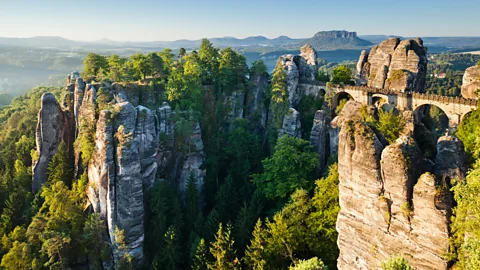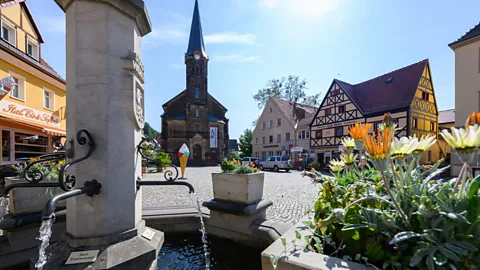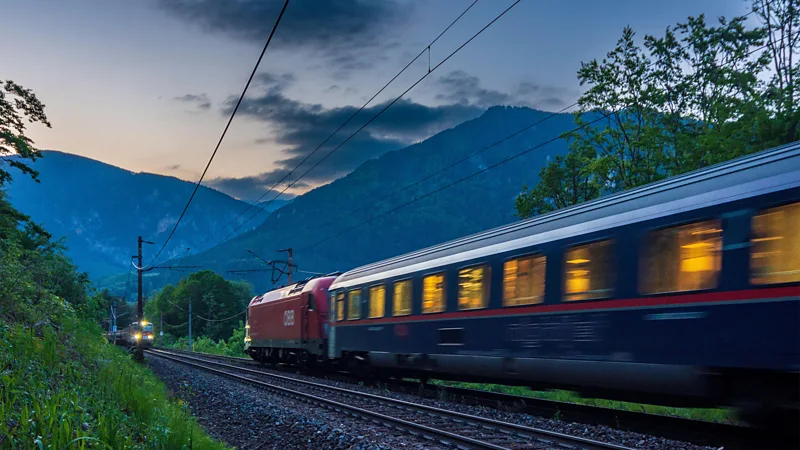In an era of cheap, low-cost flights, one throwback to the golden age of travel appears to be making a comeback: night trains. As a rail lover and carbon-conscious traveller, few things inspire me more than going to sleep in one country and waking up with a view of the countryside whizzing by, knowing that a different language and culture await me at the final stop.
That’s why I was excited to learn that, 10 months after launching its inaugural overnight service from Brussels to Berlin, the aptly named European Sleeper has recently expanded its service from Berlin to Prague. While the Brussels-to-Berlin service includes stops in Antwerp, Rotterdam and Amsterdam, the newly extended route now stops in Dresden and Bad Schandau in Germany, and Děčín, Ústí nad Labem and Prague in the Czech Republic. Travellers can choose from three ticket options: seated areas, couchettes and sleepers.
The European Sleeper is part of an ongoing renaissance in overnight European rail travel – spurred in part by the European Commission encouraging investment in night trains to help reach its climate objectives. In December 2023, Austria’s national railway, ÖBB, expanded its Nightjet sleeper train service to Berlin along its existing Vienna-to-Brussels route. After nearly a decade of suspended service, ÖBB and Germany’s national railway, Deutsche Bahn, also launched a new 15-hour Paris-to-Berlin overnight train in December. That same month, a new night train service relaunched between Paris and Aurillac in France after a 20-year hiatus.
 European SleeperThe European Sleeper offers seated, couchette and sleeping carriages (Credit: European Sleeper)
European SleeperThe European Sleeper offers seated, couchette and sleeping carriages (Credit: European Sleeper)
For all their romanticism and charm, night trains remain a niche mode of transport. Long-distance trains are generally more expensive than many equivalent flights. And routes like the European Sleeper run just three times per week, whereas direct flights between capital cities often depart several times per day. Yet, aside from the environmental benefits of train travel, night trains also stop in intriguing, lesser-known destinations where planes don’t go – like one of the European Sleeper’s new destinations, Bad Schandau.
With ticket in hand, I recently hopped aboard the European Sleeper in Berlin. My solo sleeper compartment had two seats facing each other with a faded plush covering and additional bedding above. All sleeper compartments can fit up to three travellers (standard seating and couchette options can fit six), but I paid extra to book the compartment just for me.
According to the European Sleeper’s co-founder, Chris Engelsman, many of the carriages on the Brussels-to-Berlin route date to the 1950s and ’60s, with some renovations. Yet, the newly extended line to Prague launched with more modern carriages, including couchette coaches with air conditioning. The company also has long-term plans to invest in additional refurbishments to create a new look and feel with more modern comforts.
Engelsman estimates that the European Sleeper can usually hold between 350 to 400 passengers, but the company will be adding additional carriages during the peak summer season to accommodate up to 600 people. That way, more travellers can jump on the 19:22 train in Brussels, go to bed looking at the Dutch countryside and wake up somewhere between Berlin and Dresden before finishing the homestretch to Prague by 10:56.
 Jorg Greuel/Getty ImagesThe Bastei is a stunning rock formation supporting the remains of a nearly 1,000-year-old castle (Credit: Jorg Greuel/Getty Images)
Jorg Greuel/Getty ImagesThe Bastei is a stunning rock formation supporting the remains of a nearly 1,000-year-old castle (Credit: Jorg Greuel/Getty Images)
Yet, outdoor lovers might want to consider getting off the train a few stops earlier in Bad Schandau just before 09:00. Chances are most international travellers will have never heard of this Saxony town of roughly 3,000 residents. Yet, if you love to travel off the beaten path, it’s arguably the most rewarding stop of the entire route.
Bad Schandau is the rail gateway to Germany’s Saxon Switzerland National Park. With its series of photogenic, waterfront towns set on the enchanting Elbe River and villages connected by the Malerweg hiking trail – a 116km path that wraps its way around the region, climbing some 3,600m along the way – you might think of Saxon Switzerland as Germany’s version of Italy’s famed Cinque Terre.
I’d had been interested in exploring this region since moving to Germany nearly eight years ago, so after hopping off the train at the Bad Schandau rail station, taking the short ferry ride across the shimmering Elbe River and lacing up my trail running shoes, I set out to explore the Malerweg. As an avid runner, it doesn’t get any better than weaving in between the Elbe Sandstone Mountains’ pointed peaks, feeling the air swirling around the valleys of mossy stone before climbing to the top of the Schrammsteine rock formation using a series of ladders for a panoramic view. The Elbe Sandstone Mountains run through the park like a jagged spine, and from atop the Schrammsteine, you can see the pinnacles spilling into the Czech Republic’s adjacent Bohemian Switzerland National Park.
The next day, I set off on a 3km hike along the Malerweg from the postcard-worthy medieval village of Stadt Wehlen to reach what may very well be the highlight of the region: the Bastei, a stunning rock formation formed more than a million years ago that supports the remains of a nearly 1,000-year-old castle. The Bastei has long been a tourist favourite. In 1824, the wooden Bastei Bridge was built to offer hikers the opportunity to explore the rock formation. Demand quickly spiked, leading to a more durable sandstone bridge in 1851.
 dpa picture alliance/AlamyStadt Wehlen is one of the many villages connected by hiking trails in the region (Credit: dpa picture alliance/Alamy)
dpa picture alliance/AlamyStadt Wehlen is one of the many villages connected by hiking trails in the region (Credit: dpa picture alliance/Alamy)
Today, the Bastei draws an estimated 1.5 million tourists annually, making it the most visited place in the German national park system. Yet, the crowds are manageable if you visit in the morning or during the shoulder seasons. It was about 10:00 by the time I reached Rathen, the nearest town and port to the Bastei, and ferries were already packed to the gills with tourists heading up to the Bastei.
Hiking and trail running aside, there’s something for all outdoor lovers in Saxon Switzerland National Park. Cyclists can pedal along the Elberadweg, one of the most popular long-distance cycling trails in Germany. The route travels 1,300km from the Czech Republic’s Giant Mountains (Krkonoše, in Czech) to the town of Cuxhaven, paralleling the Elbe River for the entire journey with views of the Elbe Sandstone Mountains. You can also hop on a steam ship for a river tour, or grab a paddle to canoe, kayak or raft down the Elbe River.










17 comments
I’m really enjoying the design and layout of your blog. It’s a very easy on the eyes which makes it much more enjoyable for me to come here and visit more often. Did you hire out a developer to create your theme? Excellent work!
An impressive share, I just given this onto a colleague who was doing a little analysis on this. And he in fact bought me breakfast because I found it for him.. smile. So let me reword that: Thnx for the treat! But yeah Thnkx for spending the time to discuss this, I feel strongly about it and love reading more on this topic. If possible, as you become expertise, would you mind updating your blog with more details? It is highly helpful for me. Big thumb up for this blog post!
Heya this is somewhat of off topic but I was wanting to know if blogs use WYSIWYG editors or if you have to manually code with HTML. I’m starting a blog soon but have no coding know-how so I wanted to get guidance from someone with experience. Any help would be enormously appreciated!
Hello.This post was extremely remarkable, particularly since I was investigating for thoughts on this subject last Saturday.
Terrific work! That is the type of info that should be shared across the net. Disgrace on Google for not positioning this post higher! Come on over and seek advice from my web site . Thank you =)
Can I just say what a reduction to seek out somebody who actually is aware of what theyre talking about on the internet. You positively know methods to carry an issue to mild and make it important. Extra folks must learn this and understand this aspect of the story. I cant believe youre not more widespread because you positively have the gift.
What Is Wealth Signal? the Wealth Signal isn’t just a financial tool; it’s a new way of thinking about and achieving wealth. Unlike traditional methods that focus on external strategies, Wealth Signal emphasizes changing your internal mindset.
hi!,I like your writing so much! share we communicate more about your post on AOL? I require a specialist on this area to solve my problem. May be that’s you! Looking forward to see you.
This web site is really a walk-through for all of the info you wanted about this and didn’t know who to ask. Glimpse here, and you’ll definitely discover it.
I would like to express appreciation to this writer just for rescuing me from such a trouble. Right after researching throughout the internet and seeing notions which were not helpful, I assumed my entire life was done. Living without the strategies to the problems you’ve sorted out all through your main short article is a serious case, and those that could have in a negative way affected my career if I had not discovered your web blog. Your main knowledge and kindness in touching all things was valuable. I am not sure what I would’ve done if I had not discovered such a solution like this. I’m able to now relish my future. Thank you very much for this professional and results-oriented guide. I won’t think twice to refer your web sites to anybody who desires recommendations on this problem.
Really superb info can be found on website.
I am perpetually thought about this, thankyou for posting.
I’ll right away grab your rss as I can not find your e-mail subscription link or e-newsletter service. Do you have any? Please let me know so that I could subscribe. Thanks.
This is the right blog for anyone who wants to find out about this topic. You realize so much its almost hard to argue with you (not that I actually would want…HaHa). You definitely put a new spin on a topic thats been written about for years. Great stuff, just great!
You completed a number of good points there. I did a search on the topic and found a good number of persons will consent with your blog.
Wow, wonderful blog layout! How long have you been blogging for? you made blogging look easy. The overall look of your web site is fantastic, let alone the content!
Someone necessarily assist to make significantly articles I might state. This is the first time I frequented your web page and so far? I amazed with the analysis you made to create this particular put up amazing. Fantastic activity!